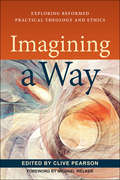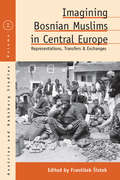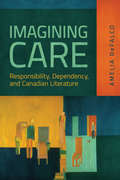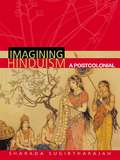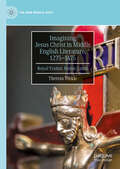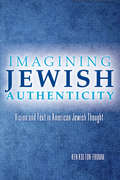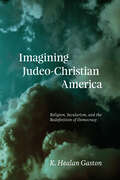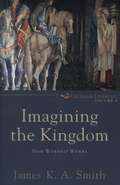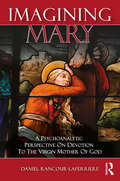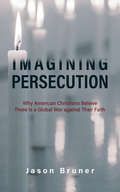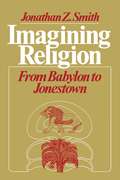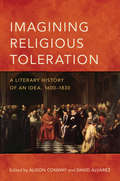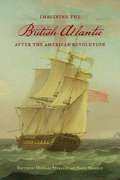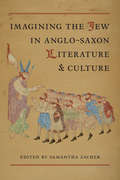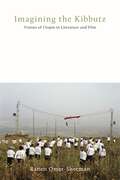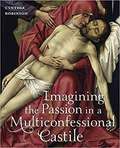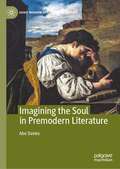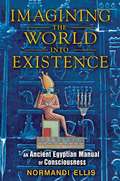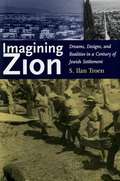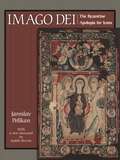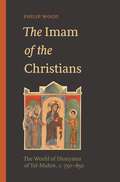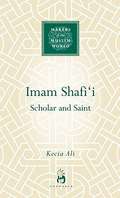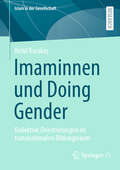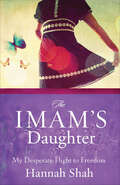- Table View
- List View
Imagining a Way: Exploring Reformed Practical Theology And Ethics
by Clive PearsonFrom the inception of the Reformed tradition, Reformed Christians have followed God's call to engage and change the world. Yet little work has been done to bring the tools of practical theology and ethics to bear on the task of understanding the Reformed tradition. This comprehensive volume addresses that problem. It gathers some of the most respected voices from within the study of Christian ethics and practical theology to ask how the Reformed tradition understands its calling into the world. What does being Reformed mean for how one engages the ills of racism, white supremacy, and homophobia? What does it mean for an environmental ethic? How does Reformed preaching and liturgy respond to sexual violence? These are among the many important issues this book seeks to address. Readers will come away with a firmer grasp of how the Reformed tradition informs and animates Christian engagement with the world. <P><P>Contributors include Denise Ackermann, Jana Childers, Susan Davies, Etienne de Villiers, Cynthia Jarvis, Jong Hyuk Kim, Ralph Kunz, Cam Murchison, Piet Naudé, Cornelius Plantinga, Nancy Ramsay, Kang Phee Ramsay, Dirk Seng, Max Smit Stackhouse, William Storrar, Geoff Thompson, and Hmar Vanlalauva.
Imagining Bosnian Muslims in Central Europe: Representations, Transfers and Exchanges (Austrian and Habsburg Studies #32)
by František ŠístekAs a Slavic-speaking religious and ethnic “Other” living just a stone’s throw from the symbolic heart of the continent, the Muslims of Bosnia and Herzegovina have long occupied a liminal space in the European imagination. To a significant degree, the wider representations and perceptions of this population can be traced to the reports of Central European—and especially Habsburg—diplomats, scholars, journalists, tourists, and other observers in the late nineteenth and early twentieth centuries. This volume assembles contributions from historians, anthropologists, political scientists, and literary scholars to examine the political, social, and discursive dimensions of Bosnian Muslims’ encounters with the West since the nineteenth century.
Imagining Care: Responsibility, Dependency, and Canadian Literature
by Amelia DefalcoImagining Care brings literature and philosophy into dialogue by examining caregiving in literature by contemporary Canadian writers alongside ethics of care philosophy. Through close readings of fiction and memoirs by Margaret Atwood, Alice Munro, Michael Ignatieff, Ian Brown, and David Chariandy, Amelia DeFalco argues that these narratives expose the tangled particularities of relations of care, dependency, and responsibility, as well as issues of marginalisation on the basis of gender, race, and class.DeFalco complicates the myth of Canada as an unwaveringly caring nation that is characterized by equality and compassion. Caregiving is unpredictable: one person's altruism can be another's narcissism; one's compassion, another's condescension or even cruelty. In a country that conceives of itself as a caring society, these texts depict in stark terms the ethical dilemmas that arise from our attempts to respond to the needs of others.
Imagining Hinduism: A Postcolonial Perspective
by Sharada SugirtharajahImagining Hinduism examines how Hinduism has been defined, interpreted and manufactured through Western categorizations, from the foreign interventions of eighteenth and nineteenth-century Orientalists and missionaries, to the present day. Sugirtharajah argues that ever since early Orientalists 'discovered' the ancient Sanskrit texts and the Hindu 'golden age', the West has nurtured a complex and ambivalent fascination with Hinduism, ranging from romantic admiration to ridicule. At the same time, Hindu discourse has drawn upon Orientalist representations in order to redefine Hindu identity.As the first comprehensive work to bring postcolonial critique to the study of Hinduism, this is essential reading for those seeking a full understanding of Hinduism.
Imagining Jesus Christ in Middle English Literature, 1275-1475: Royal Traitor, Heroic Lamb (The New Middle Ages)
by Theresa TinkleThis book interprets Jesus Christ as a complicated, disunified literary character in Middle English literature, where he appears variously as king, traitor, victorious conqueror, sacrificial lamb, heroic knight, lover, and spouse--often as several contradictory figures in a single work. These tropes derive from Scripture, doctrines about Christ's two natures, and theories of redemption. This book examines the full range of representations in Southern Passion, Northern Passion, Pepysian Gospel Harmony, Stanzaic Life of Christ, Cursor Mundi, Nicholas Love’s Mirror of the Blessed Life of Jesus Christ, Sir John Mandeville’s Book, the York Play, and Julian of Norwich's Revelation of Love. Although Christ's two natures are well represented in existing scholarship, many traditions have been overlooked, including commonplace treatments of Christ as both a traitor and king, conqueror and sacrificial lamb, hero and lover. As writers call upon audiences to feel compassion for Jesus's suffering, they almost universally express antipathy toward his Jewish torturers, complicating our ideas about affective piety. In these works, the Virgin Mary is less exemplary for her compassion than for her understanding of doctrine. In short, this book offers new perspectives on vernacular Christology between about 1275 and 1475. Theresa Tinkle is a Professor within the Department of English Language and Literature at the University of Michigan, USA, as well as Director of the Gayle Morris Sweetland Center for Writing. Previous publications include Medieval Venuses and Cupids: Sexuality and Hermeneutics in English Poetry (1996) and Gender and Power in Medieval Exegesis (Palgrave, 2010). Theresa’s academic training and publications include the study of medieval English and Latin literature, the medieval reception of the Bible, gender and sexuality studies, paleography and manuscript studies, composition and pedagogy, and disability studies.
Imagining Jewish Authenticity
by Ken Koltun-FrommExploring how visual media presents claims to Jewish authenticity, Imagining Jewish Authenticity argues that Jews imagine themselves and their place within America by appealing to a graphic sensibility. Ken Koltun-Fromm traces how American Jewish thinkers capture Jewish authenticity, and lingering fears of inauthenticity, in and through visual discourse and opens up the subtle connections between visual expectations, cultural knowledge, racial belonging, embodied identity, and the ways images and texts work together.
Imagining Judeo-Christian America: Religion, Secularism, and the Redefinition of Democracy
by K. Healan Gaston“Judeo-Christian” is a remarkably easy term to look right through. Judaism and Christianity obviously share tenets, texts, and beliefs that have strongly influenced American democracy. In this ambitious book, however, K. Healan Gaston challenges the myth of a monolithic Judeo-Christian America. She demonstrates that the idea is not only a recent and deliberate construct, but also a potentially dangerous one. From the time of its widespread adoption in the 1930s, the ostensible inclusiveness of Judeo-Christian terminology concealed efforts to promote particular conceptions of religion, secularism, and politics. Gaston also shows that this new language, originally rooted in arguments over the nature of democracy that intensified in the early Cold War years, later became a marker in the culture wars that continue today. She argues that the debate on what constituted Judeo-Christian—and American—identity has shaped the country’s religious and political culture much more extensively than previously recognized.
Imagining The Kingdom: How Worship Works (Cultural Liturgies, Vol. #2)
by James K. A. SmithHow does worship work? How exactly does liturgical formation shape us? What are the dynamics of such transformation? In the second of James K. A. Smith's three-volume theology of culture, the author expands and deepens the analysis of cultural liturgies and Christian worship he developed in his well-received Desiring the Kingdom. He helps us understand and appreciate the bodily basis of habit formation and how liturgical formation--both "secular" and Christian--affects our fundamental orientation to the world. Worship "works" by leveraging our bodies to transform our imagination, and it does this through stories we understand on a register that is closer to body than mind. This has critical implications for how we think about Christian formation. Professors and students will welcome this work as will pastors, worship leaders, and Christian educators. The book includes analyses of popular films, novels, and other cultural phenomena, such as The King's Speech, Rise of the Planet of the Apes, David Foster Wallace's Infinite Jest, and Facebook.
Imagining Mary: A Psychoanalytic Perspective on Devotion to the Virgin Mother of God
by Daniel Rancour-LaferriereImagining Mary breaks new ground in the long tradition of Christian mariology. The book is an interdisciplinary investigation of some of the many Marys, East and West, from the New Testament Mary of Nazareth down to Our Lady of the Good Death in the twentieth century. In Imagining Mary, Professor Rancour-Laferriere examines the mother of God in her multireligious and pan-historical context. The book is a scholarly study, but it is written in a clear, straightforward style and will be comprehensible to an educated – and, above all, intellectually curious – general audience. It will appeal to anyone who has ever wondered, for example, about the flimsy scriptural basis of many beliefs about Mary; or the tendency of many mariologists to depict Mary as an incestuous "bride of Christ"; or the theological notion of Mary’s "loving consent" to her son’s crucifixion; or the idea that Mary was a "priest" officiating at the sacrifice of her son; or the unfortunate association of Mary with Christian anti-semitism; or the curious appeal of Mary to the terminally ill; and so on. Special attention is given to the psychology of representations of Mary, such as: the psychological basis for promoting Mary to the status of a "goddess"; the psychology of Mary’s compassion for her son at the foot of the cross; and the psychological conflict in Mary’s personal relationship with her son Jesus. These topics are admittedly diverse, but they all have long been on the minds of mariologists. The author takes a questioning approach to received wisdom about marian themes – including the assumption that one has to be a theist in order to understand the great appeal of Mary down the centuries. Indeed, Imagining Mary may be regarded as a first step in the direction of an atheist mariology.
Imagining Persecution: Why American Christians Believe There Is a Global War against Their Faith
by Jason BrunerMany American Christians have come to understand their relationship to other Christian denominations and traditions through the lens of religious persecution. This book provides a historical account of these developments, showing the global, theological, and political changes that made it possible for contemporary Christians to claim that there is a global war on Christians. Bruner does not advocate on behalf of particular repressed Christian communities, nor does it argue for the genuineness of certain Christians’ claims of persecution. Instead, this book is the first to examine the idea that there is a “global war on Christians” and its analytical implications. It does so by giving a concise history of categories such as "martyr" and theologies that have come together to produce a global Christian imagination premised upon the notion of shared suffering for one’s faith. This history does not deny certain instances of suffering or death; rather, it sets out to reflect upon and make meaning of the consequences for thinking about religious violence and Christianity worldwide using terms such as a “global war on Christians.”
Imagining Religion: From Babylon to Jonestown (Chicago Studies in the History of Judaism)
by Jonathan Z. SmithWith this influential book of essays, Jonathan Z. Smith has pointed the academic study of religion in a new theoretical direction, one neither theological nor willfully ideological. Making use of examples as apparently diverse and exotic as the Maori cults in nineteenth-century New Zealand and the events of Jonestown, Smith shows that religion must be construed as conventional, anthropological, historical, and as an exercise of imagination. In his analyses, religion emerges as the product of historically and geographically situated human ingenuity, cognition, and curiosity—simply put, as the result of human labor, one of the decisive but wholly ordinary ways human beings create the worlds in which they live and make sense of them. "These seven essays . . . display the critical intelligence, creativity, and sheer common sense that make Smith one of the most methodologically sophisticated and suggestive historians of religion writing today. . . . Smith scrutinizes the fundamental problems of taxonomy and comparison in religious studies, suggestively redescribes such basic categories as canon and ritual, and shows how frequently studied myths may more likely reflect situational incongruities than vaunted mimetic congruities. His final essay, on Jonestown, demonstrates the interpretive power of the historian of religion to render intelligible that in our own day which seems most bizarre."—Richard S. Sarason, Religious Studies Review
Imagining Religious Toleration: A Literary History of an Idea, 1600–1830
by Alison Conway David AlvarezFormerly a site of study reserved for intellectual historians and political philosophers, scholarship on religious toleration, from the perspective of literary scholars, is fairly limited. Largely ignored and understudied techniques employed by writers to influence cultural understandings of tolerance are rich for exploration. In investigating the eighteenth-century novel, Alison Conway, David Alvarez, and their contributors shed light on what literature can say about toleration, and how it can produce and manage feelings of tolerance and intolerance. Beginning with an overview of the historical debates surrounding the terms "toleration" and "tolerance," this book moves on to discuss the specific contributions that literature and literary modes have made to cultural history, studying the literary techniques that philosophers, theologians, and political theorists used to frame the questions central to the idea and practice of religious toleration. Tracing the rhetoric employed by a wide range of authors, the contributors delve into topics such as conversion as an instrument of power in Shakespeare; the relationship between religious toleration and the rise of Enlightenment satire; and the ways in which writing can act as a call for tolerance.
Imagining the British Atlantic after the American Revolution
by Michael Meranze Saree MakdisiBetween 1750 and 1820, tides of revolution swept the Atlantic world. From the new industrial towns of Great Britain to the plantations of Haiti, they heralded both the rise of democratic nationalism and the subsequent surge of imperial reaction.In Imagining the British Atlantic after the American Revolution, nine essays consider these revolutionary transformations from a variety of literary, visual, and historical perspectives. On topics ranging from painting and poetry to prison reform, the essays challenge and complicate our understandings of revolution and reaction within the transatlantic imagination. Drawing on examples from different local and regional contexts, they demonstrate the many remarkably local ways that revolution and empire were experienced in London, Pennsylvania, Pitcairn Island, and points in between.Published by the University of Toronto Press in association with the UCLA Center for Seventeenth- and Eighteenth-Century Studies and the William Andrews Clark Memorial Library.
Imagining the Jew in Anglo-Saxon Literature and Culture
by Samantha ZacherMost studies of Jews in medieval England begin with the year 1066, when Jews first arrived on English soil. Yet the absence of Jews in England before the conquest did not prevent early English authors from writing obsessively about them. Using material from the writings of the Church Fathers, contemporary continental sources, widespread cultural stereotypes, and their own imaginations, their depictions of Jews reflected their own politico-theological experiences.The thirteen essays in Imagining the Jew in Anglo-Saxon Literature and Culture examine visual and textual representations of Jews, the translation and interpretation of Scripture, the use of Hebrew words and etymologies, and the treatment of Jewish spaces and landmarks. By studying the "imaginary Jews" of Anglo-Saxon England, they offer new perspectives on the treatment of race, religion, and ethnicity in pre- and post-conquest literature and culture.
Imagining the Kibbutz: Visions of Utopia in Literature and Film (Dimyonot: Jews and the Cultural Imagination #2)
by Ranen Omer-ShermanIn Imagining the Kibbutz, Ranen Omer-Sherman explores the literary and cinematic representations of the socialist experiment that became history’s most successfully sustained communal enterprise. Inspired in part by the kibbutz movement’s recent commemoration of its centennial, this study responds to a significant gap in scholarship. Numerous sociological and economic studies have appeared, but no book-length study has ever addressed the tremendous range of critically imaginative portrayals of the kibbutz. This diachronic study addresses novels, short fiction, memoirs, and cinematic portrayals of the kibbutz by both kibbutz “insiders” (including those born and raised there, as well as those who joined the kibbutz as immigrants or migrants from the city) and “outsiders.” For these artists, the kibbutz is a crucial microcosm for understanding Israeli values and identity. The central drama explored in their works is the monumental tension between the individual and the collective, between individual aspiration and ideological rigor, between self-sacrifice and self-fulfillment. Portraying kibbutz life honestly demands retaining at least two oppositional things in mind at once—the absolute necessity of euphoric dreaming and the mellowing inevitability of disillusionment. As such, these artists’ imaginative witnessing of the fraught relation between the collective and the citizen-soldier is the story of Israel itself.
Imagining the Kibbutz: Visions of Utopia in Literature and Film (Dimyonot)
by Ranen Omer-ShermanIn Imagining the Kibbutz, Ranen Omer-Sherman explores the literary and cinematic representations of the socialist experiment that became history’s most successfully sustained communal enterprise. Inspired in part by the kibbutz movement’s recent commemoration of its centennial, this study responds to a significant gap in scholarship. Numerous sociological and economic studies have appeared, but no book-length study has ever addressed the tremendous range of critically imaginative portrayals of the kibbutz. This diachronic study addresses novels, short fiction, memoirs, and cinematic portrayals of the kibbutz by both kibbutz “insiders” (including those born and raised there, as well as those who joined the kibbutz as immigrants or migrants from the city) and “outsiders.” For these artists, the kibbutz is a crucial microcosm for understanding Israeli values and identity. The central drama explored in their works is the monumental tension between the individual and the collective, between individual aspiration and ideological rigor, between self-sacrifice and self-fulfillment. Portraying kibbutz life honestly demands retaining at least two oppositional things in mind at once—the absolute necessity of euphoric dreaming and the mellowing inevitability of disillusionment. As such, these artists’ imaginative witnessing of the fraught relation between the collective and the citizen-soldier is the story of Israel itself.
Imagining the Passion in a Multiconfessional Castile
by Cynthia RobinsonRecent research into the texts, practices, and visual culture of late medieval devotional life in western Europe has clearly demonstrated the centrality of devotions to Christ’s Passion. The situation in Castile, however, could not have been more different. Prior to the final decades of the fifteenth century, individual relationships to Christ established through the use of “personalized” Passion imagery simply do not appear to have been a component of Castilian devotional culture.
Imagining the Soul in Premodern Literature (Early Modern Literature in History)
by Abe DaviesThis book is a study of ghostly matters - of the soul - in literature spanning the tenth century and the age of Shakespeare. All people, according to John Donne, ‘constantly beleeve’ that they have an immortal soul. But he also reflects that in fact there is nothing ‘so well established as constrains us to beleeve, both that the soul is immortall, and that every particular man hath such a soul’. In understanding the question of man's disembodied part as at once fundamental and fundamentally uncertain he was entirely of his time, and Imagining the Soul in Premodern Literature considers this fraught, shifting, yet uniquely compelling entity in the context of the literary forms and effects involved in its representation. Gruesome medieval dialogues between damned souls and worm-eaten bodies; verse and prose works by Donne, René Descartes, Margaret Cavendish and Andrew Marvell; a profusion of sonnet sequences, sermons, manuals of instruction and travelogues; Hamlet and its natural philosophical thinking about the apparently disembodied soul haunting Elsinore: these chapters range across all this and more, offering a rigorous yet accessible account of an essential aspect of premodern literature that will be of interest to scholars, students and the general reader alike.
Imagining the World into Existence: An Ancient Egyptian Manual of Consciousness
by Normandi EllisReveals the secret language and words of power that enabled the ancient Egyptians to imagine the world into existence • Reveals ancient Egyptian Mystery teachings on immaculate conception, transubstantiation, resurrection, and eternal life • Explores the shamanic journeys that ancient Egyptian priests used to view the unconscious and the afterlife • Provides the essential spiritual tools needed to return to Zep Tepi, the creative source Drawing from the Egyptian Book of the Dead, the Pyramid texts, the Book of Thoth, and other sacred hieroglyphic writings spanning the three millennia of the Egyptian Mystery Traditions, Normandi Ellis reveals the magical language of creation and words of power that enabled the ancient Egyptians to act as co-creators with the gods. Examining the power of hieroglyphic thinking--how thoughts create reality--and the multiple meanings behind every word of power, the author shows how, with the Neteru, we imagine the world into existence, casting a spell of consciousness over the material world. Uncovering the deep layers of meaning and symbol within the myths of the Egyptian gods and goddesses, Ellis investigates the shamanic journeys that ancient Egyptian priests used to view the unconscious and the afterlife and shares their initiations for immaculate conception, transubstantiation, resurrection, and eternal life—initiations that later became part of the Christian mystery school. Revealing the words of power used by these ancient priests/sorcerers, she explains how to search for the deeper, hidden truths beneath their spells and shows how ancient Egyptian consciousness holds the secret of life itself. Revealing the initiatory secrets of the Osirian Mystery school, Ellis provides the essential teachings and shamanic tools needed to return to Zep Tepi--the creative source--as we face the transitional time of radical change currently at hand.
Imagining Zion: Dreams, Designs, and Realities in a Century of Jewish Settlement
by S. Ilan TroenThis timely book tells the fascinating story of how Zionists colonizers planned and established nearly 700 agricultural settlements, towns, and cities from the 1880s to the present. This extraordinary activity of planners, architects, social scientists, military personnel, politicians, and settlers is inextricably linked to multiple contexts: Jewish and Zionist history, the Arab/Jewish conflict, and the diffusion of European ideas to non-European worlds. S. Ilan Troen demonstrates how professionals and settlers continually innovated plans for both rural and urban frontiers in response to the competing demands of social and political ideologies and the need to achieve productivity, economic independence, and security in a hostile environment. In the 1930s, security became the primary challenge, shaping and even distorting patterns of growth. Not until the 1993 Oslo Accords, with prospects of compromise and accommodation, did planners again imagine Israel as a normal state, developing like other modern societies. Troen concludes that if Palestinian Arabs become reconciled to a Jewish state, Israel will reassign priority to the social and economic development of the country and region.
Imago Dei: The Byzantine Apologia for Icons (The A. W. Mellon Lectures in the Fine Arts #36)
by Jaroslav PelikanA sweeping account of the controversies surrounding the worship of images in the early Byzantine churchIn 726, the Byzantine emperor, Leo III, issued an edict that all religious images in the empire were to be destroyed, a directive that was later endorsed by a synod of the church in 753 under his son, Constantine V. If the policy of Iconoclasm had succeeded, the entire history of Christian art—and of the Christian church, at least in the East—would have been altered.Iconoclasm was defeated by Byzantine politics, popular revolts, monastic piety, and, most fundamentally of all, by theology, just as it had been theology that the opponents of images had used to justify their actions. Analyzing an intriguing chapter in the history of ideas, the renowned scholar Jaroslav Pelikan shows how a faith that began by attacking the worship of images ended first in permitting and then in commanding it.Pelikan charts the theological defense of icons during the iconoclastic controversies of the eighth and ninth centuries, whose high point came in 787, when the Second Council of Nicaea restored the cult of images in the church. He demonstrates how the dogmas of the Trinity and the Incarnation eventually provided the basic rationale for images: because the invisible God had become human and therefore personally visible in Jesus Christ, it became permissible to make images of that Image. And because not only the human nature of Christ, but that of his Mother had been transformed by the Incarnation, she, too, could be “iconized,” together with all the other saints and angels.The iconographic “text” of the book is provided by one of the very few surviving icons from the period before Iconoclasm, the Egyptian tapestry Icon of the Virgin now in the Cleveland Museum of Art. Other icons serve to illustrate the theological argument, just as the theological argument serves to explain the icons.In an incisive foreword, Judith Herrin explains the enduring importance of the book and discusses how later scholars have built on Pelikan’s work.Please note: All images in this ebook are presented in black and white and have been reduced in size.
The Imam of the Christians: The World of Dionysius of Tel-Mahre, c. 750–850
by Philip WoodHow Christian leaders adapted the governmental practices and political thought of their Muslim rulers in the Abbasid caliphateThe Imam of the Christians examines how Christian leaders adopted and adapted the political practices and ideas of their Muslim rulers between 750 and 850 in the Abbasid caliphate in the Jazira (modern eastern Turkey and northern Syria). Focusing on the writings of Dionysius of Tel-Mahre, the patriarch of the Jacobite church, Philip Wood describes how this encounter produced an Islamicate Christianity that differed from the Christianities of Byzantium and western Europe in far more than just theology. In doing so, Wood opens a new window on the world of early Islam and Muslims’ interactions with other religious communities.Wood shows how Dionysius and other Christian clerics, by forging close ties with Muslim elites, were able to command greater power over their coreligionists, such as the right to issue canons regulating the lives of lay people, gather tithes, and use state troops to arrest opponents. In his writings, Dionysius advertises his ease in the courts of ʿAbd Allah ibn Tahir in Raqqa and the caliph al-Ma’mun in Baghdad, presenting himself as an effective advocate for the interests of his fellow Christians because of his knowledge of Arabic and his ability to redeploy Islamic ideas to his own advantage. Strikingly, Dionysius even claims that, like al-Ma’mun, he is an imam since he leads his people in prayer and rules them by popular consent.A wide-ranging examination of Middle Eastern Christian life during a critical period in the development of Islam, The Imam of the Christians is also a case study of the surprising workings of cultural and religious adaptation.
Imam Shafi'i: Scholar and Saint (Makers of the Muslim World)
by Kecia AliIn this innovative study, Kecia Ali examines the forefather of the second largest of the four principal Sunni schools of jurisprudence, the Shafi'i. Gifted poet and outstanding Islamic Scholar, Abu Abdullah Muhammad ibn Idris al-Shafi'i (767-820) firmly rejected the use of common sense in Islamic legal rulings, arguing that the only valid sunnah (or prophetic religious traditions) were directly handed down from Muhammad by Hadith. Kecia Ali is Assistant Professor of Religion at Boston University. She is a world authority on Islamic jurisprudence, and author of Sexual Ethics and Islam: Feminist Reflections on Qur'an, Hadith and Jurisprudence.
Imaminnen und Doing Gender: Kollektive Orientierungen im transnationalen Bildungsraum (Islam in der Gesellschaft)
by Betül KarakoçMoscheen als binär codierte Binnenräume spannen transnationale Bildungsräume auf und stoßen Erziehungs- und Bildungsprozesse an. Durch pädagogische und religiöse Handlungsfelder eröffnen sie Räume der religiösen Wissensvermittlung oder der politischen Bildung, aber auch Räume der Geschlechtererziehung, in denen die Teilhabenden Normen- und Wertevorstellungen verhandeln. Imaminnen in Moscheen lassen sich dabei als pädagogische Orientierungspersonen verstehen, die durch ihre Handlungsfelder Geschlechtervorstellungen verfestigen und an der Konstruktion und Konstitution von Geschlecht mitwirken. Vor diesem Hintergrund rückt die Studie türkische und deutsch-türkische Imaminnen in DITIB-Moscheen in den Vordergrund und rekonstruiert die kollektiven Orientierungen und Modi der Bearbeitung in den Geschlechterkonstruktionen – im Doing Gender – der Imaminnen, die an den theologischen Fakultäten in Ankara und Konya (Türkei) und in unterschiedlichen Moscheegemeinden in Hessen interviewt wurden. Die Studie gibt folglich Aufschlüsse, wie sich Doing Gender im transnationalen Bildungsraum gestaltet und Geschlechterkonstruktionen transnational wirkmächtig werden.
The Imam's Daughter: My Desperate Flight to Freedom
by Hannah ShahHannah Shah is an Imam's daughter. She lived the life of a devout Muslim in a family of Pakistani Muslims in England, but behind the front door, she was a caged butterfly.For many years, her father abused her in the cellar of their home. At sixteen, she discovered a plan to send her to Pakistan for an arranged marriage, and she gathered the courage to run away. Relentlessly hunted by her angry father and brothers, who were intent on executing an "honor" killing, she moved from house to house in perpetual fear to escape them. Over time, she converted to Christianity and was able to live and marry as she wished.Hannah found the courage to live her life free from shame, free from religious intolerance, and free from the abuse that haunted her childhood. This is a remarkable true story of how a young girl escaped a life of torture . . . a story you won't forget.
